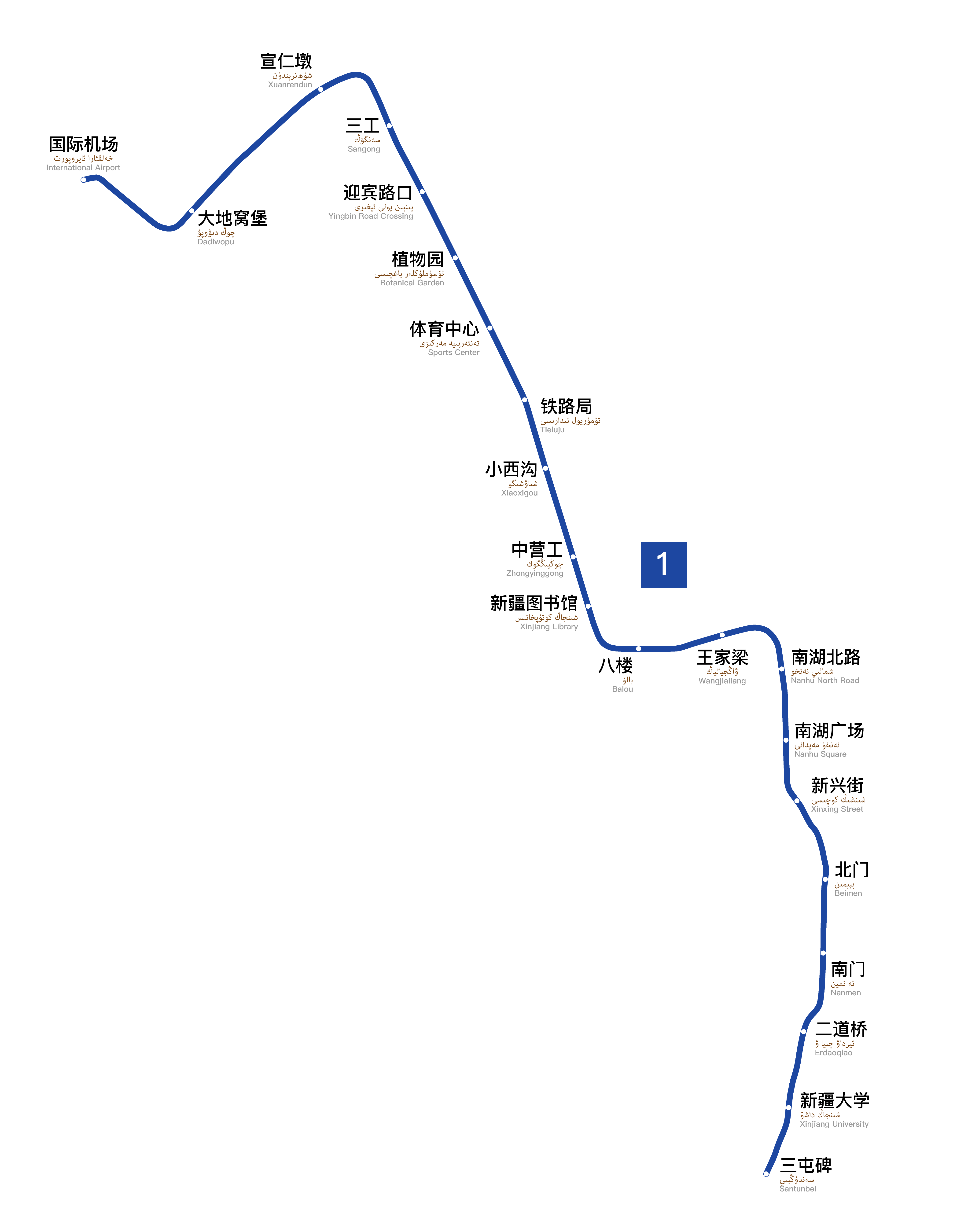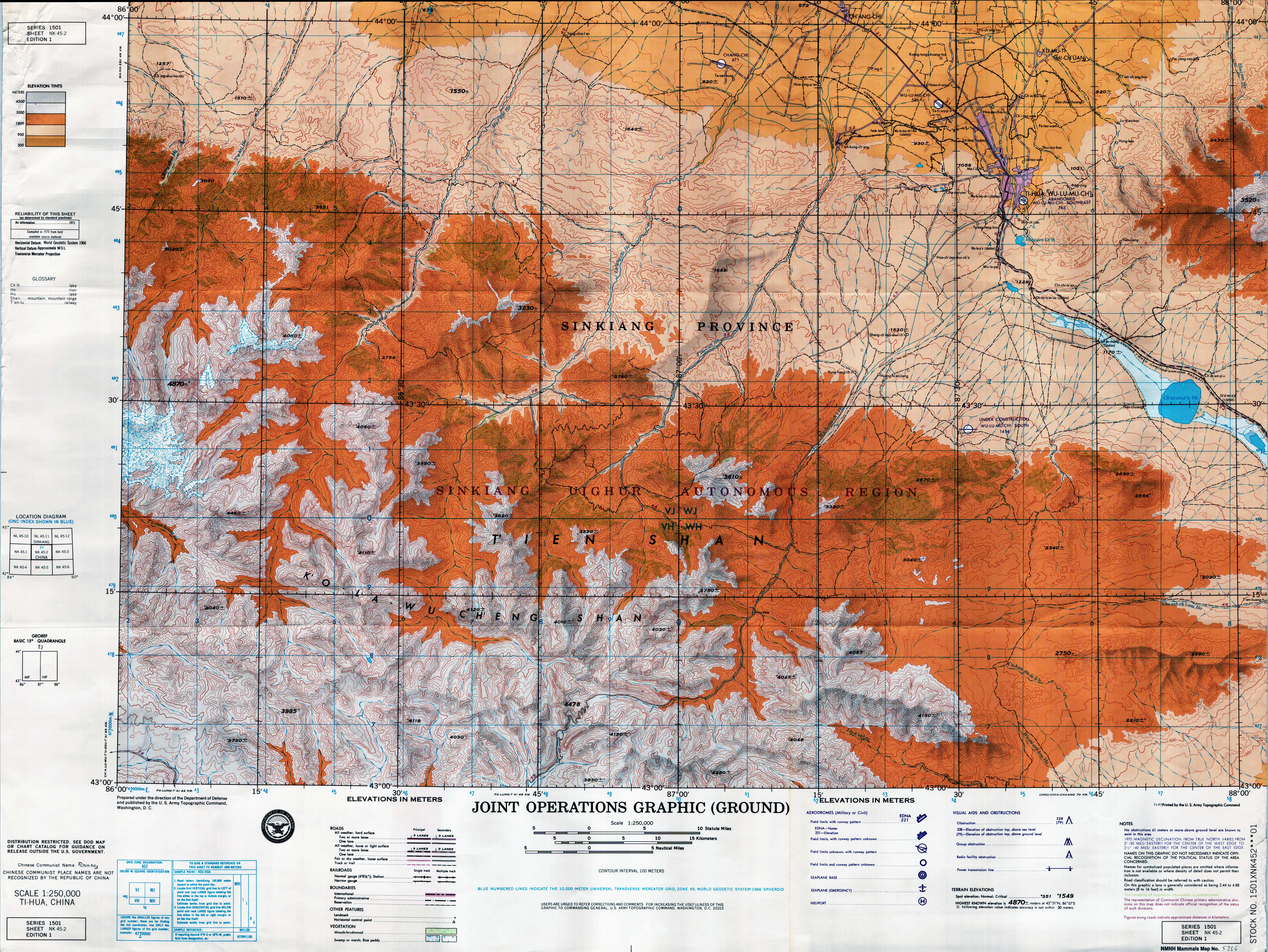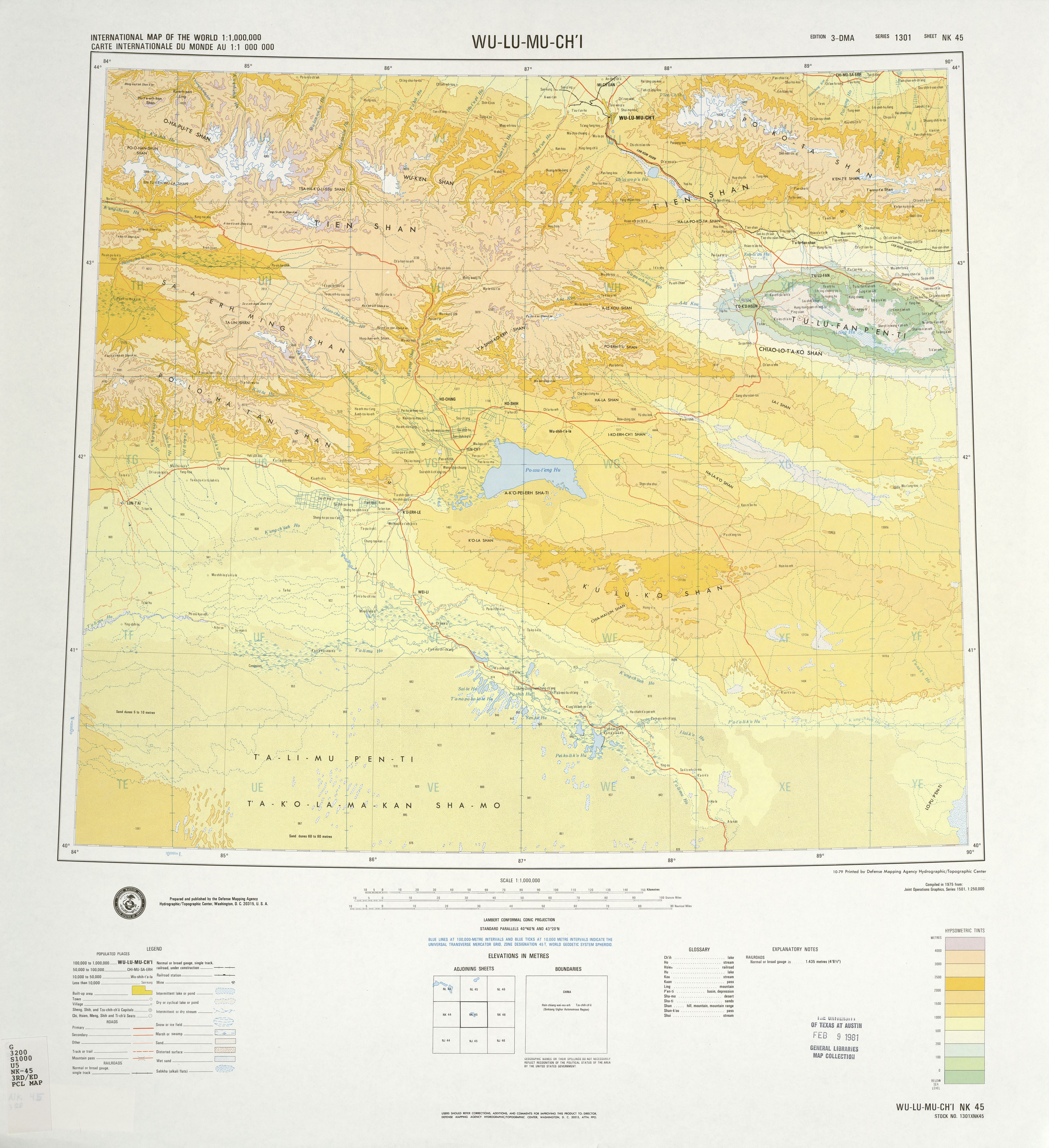|
ÃrÃŒmqi Metro
The ÃrÃŒmqi Metro or ÃrÃŒmqi Subway is a rapid transit system in operation in ÃrÃŒmqi, capital of the Xinjiang Autonomous Region in China. It is the 35th rapid transit system to be put into operation on the Chinese mainland and the second in northwest China. The ÃrÃŒmqi Metro has submitted plans for two lines, Line 1 and Line 2, with an estimated cost of 31.24 billion yuan. Lines Line 1 Line 1 runs from ÃrÃŒmqi Tianshan International Airport through downtown ÃrÃŒmqi and ends at Santunbei station. It has a total length of 27.615 km and 21 stations. It is fully underground. Line 1 started construction on 20 March 2014. The northern section of the line was opened on 25 October 2018. The southern section of the line was opened on 28 June 2019. Airport MRT The Airport MRT was opened on 17 April 2025, and runs in ÃrÃŒmqi Diwopu International Airport only. It consists of two stations, namely International Airport and International Airport North. This is treated as a shuttle ... [...More Info...] [...Related Items...] OR: [Wikipedia] [Google] [Baidu] [Amazon] |
Line 1 (ÃrÃŒmqi Metro)
Line 1 of the ÃrÃŒmqi Metro is a subway line in ÃrÃŒmqi. The northern section from to Balou Station, Balou, was opened on 25 October 2018. The southern section from Balou Station, Balou to Santunbei station, Santunbei opened on 28 June 2019. In April a 6 km long section from International Airport to East International Airport started operation. After the first two section opened Line 1 had a total length of 27.615 km and 21 stations. It is fully underground. History Line 1 commenced construction in March 2014. Tunneling works were completed in December 2017. The northern section of Line 1 (16.5 km) opened on 25 October 2018. The southern section of Line 1 (11.1 km) opened on 28 June 2019. Opening timeline Stations References {{Xinjiang transit Rail transport in Xinjiang Rapid transit lines in China Railway lines opened in 2018 2018 establishments in China Airport rail links in China ... [...More Info...] [...Related Items...] OR: [Wikipedia] [Google] [Baidu] [Amazon] |
ÃrÃŒmqi Metro Map
ÃrÃŒmqi, , is the capital of the Xinjiang Uyghur Autonomous Region in Northwestern China. With a census population of 4 million in 2020, ÃrÃŒmqi is the second-largest city in China's northwestern interior after Xi'an, also the second-largest in Central Asia in terms of population, right after Kabul, Afghanistan. ÃrÃŒmqi has seen significant economic development since the 1990s and currently serves as a regional transport node and a cultural, political and commercial center. Etymology The name ÃrÃŒmqi comes from the Mongolic Oirat language and means "beautiful pasture" (, ). It was originally the name of a small town founded by the Mongolic, Oirat-speaking Dzungars. The Qing dynasty took ÃrÃŒmqi by force in 1755, during its conquest of the Dzungar Khanate. Qing forces expanded the town into a walled city from 1763 to 1767, and upon completing the expansion renamed the city Dihua ( zh, c=迪å, links=no; previously romanized as Tihwa), meaning "to enlighten and ... [...More Info...] [...Related Items...] OR: [Wikipedia] [Google] [Baidu] [Amazon] |
Transport In ÃrÃŒmqi
Transport (in British English) or transportation (in American English) is the intentional Motion, movement of humans, animals, and cargo, goods from one location to another. Mode of transport, Modes of transport include aviation, air, land transport, land (rail transport, rail and road transport, road), ship transport, water, cable transport, cable, pipeline transport, pipelines, and space transport, space. The field can be divided into infrastructure, vehicles, and operations. Transport enables human trade, which is essential for the development of civilizations. Transport infrastructure consists of both fixed installations, including roads, railways, airway (aviation), airways, waterways, canals, and pipeline transport, pipelines, and terminals such as airports, train station, railway stations, bus stations, warehouses, trucking terminals, refueling depots (including fuel docks and fuel stations), and seaports. Terminals may be used both for the interchange of passengers and ... [...More Info...] [...Related Items...] OR: [Wikipedia] [Google] [Baidu] [Amazon] |
Rapid Transit In China
Urban rail transit in China encompasses a broad range of urban and suburban electric passenger rail mass transit systems including subway, light rail, tram and maglev. Some classifications also include non-rail bus rapid transport. As of December 2024, China has the world's longest urban rail transit system with of urban rail nationwide in 310 metro lines in 47 cities, accounting for 9 of the 10 longest metro systems, with the exceptions of the Moscow Metro. Half of the top 10 busiest metro systems are in China, and the Shanghai Metro, though started operating in 1993, is now the longest metro system worldwide.Archived aGhostarchiveand thWayback Machine History Several Chinese cities had urban electric tramways in the early 20th century, most of which were dismantled in the 1950sâ1970s. The only surviving tramways are in Dalian (Dairen) and Changchun (see trams in Dalian and trams in Changchun). Nanjing (Nanking) had from 1907 to 1958. The first subway ... [...More Info...] [...Related Items...] OR: [Wikipedia] [Google] [Baidu] [Amazon] |
ÃrÃŒmqi BRT
ÃrÃŒmqi Bus Rapid Transit (BRT) is a bus rapid transit system in ÃrÃŒmqi, Xinjiang, China China, officially the People's Republic of China (PRC), is a country in East Asia. With population of China, a population exceeding 1.4 billion, it is the list of countries by population (United Nations), second-most populous country after .... It began trial operations in August 2011 and officially began operations in September of the same year. Lines * BRT1: in length, 21 stations, * BRT2: in length, 17 stations, * BRT3: in length, 17 stations, * BRT5: in length, 11 stations. References External links ä¹é²æšéœBRTå¿«éå ¬äº€(Chinese) Bus Rapid Transit Bus rapid transit in China {{China-stub ... [...More Info...] [...Related Items...] OR: [Wikipedia] [Google] [Baidu] [Amazon] |
Urban Rail Transit In China
Urban rail transit in China encompasses a broad range of urban and suburban electric passenger rail mass transit systems including subway, light rail, tram and maglev. Some classifications also include non-rail bus rapid transport. As of December 2024, China has the world's longest urban rail transit system with of urban rail nationwide in 310 metro lines in 47 cities, accounting for 9 of the 10 longest metro systems, with the exceptions of the Moscow Metro. Half of the top 10 busiest metro systems are in China, and the Shanghai Metro, though started operating in 1993, is now the longest metro system worldwide.Archived aGhostarchiveand thWayback Machine History Several Chinese cities had urban electric tramways in the early 20th century, most of which were dismantled in the 1950sâ1970s. The only surviving tramways are in Dalian (Dairen) and Changchun (see trams in Dalian and trams in Changchun). Nanjing (Nanking) had from 1907 to 1958. The first subway i ... [...More Info...] [...Related Items...] OR: [Wikipedia] [Google] [Baidu] [Amazon] |
List Of Metro Systems
This list of metro systems includes electrified rapid transit train systems worldwide. In some parts of the world, metro systems are referred to as subways, undergrounds, tubes, mass rapid transit (MRT), metrÃŽ or U-Bahn. 204 cities in 65 countries operate 917 metro lines. The London Underground first opened as an underground railway in 1863 and its first electrified underground line, the City and South London Railway, opened in 1890, making it the world's first deep-level electric metro system. The Budapest Millennium Underground Railway, which opened in 1896, was the world's first electric underground railway specifically designed for urban transportation and is still in operation today. The Shanghai Metro is both the world's longest metro network at and the busiest with the highest annual ridership reaching approximately 2.83 billion passenger trips. The New York City Subway has the greatest number of stations, with 472. the country with the most metro systems is Chi ... [...More Info...] [...Related Items...] OR: [Wikipedia] [Google] [Baidu] [Amazon] |
Airport MRT
Taiwan Taoyuan International Airport MRT (Mass Rapid Transit), commonly known as the Airport MRT, is a rapid transit line of the Taoyuan Metro that connects Taipei, Taoyuan and New Taipei with Taoyuan International Airport in northern Taiwan. The line has 22 stations, from Taipei Main Station to , and began commercial service on 2 March 2017. Commuter and Express services operate on the line, which features in-town check-in and baggage check at Taipei Main Station and at . An extension to Zhongli railway station via from the current terminus at is under construction. The Laojie River metro station opened in July 2023 and the full extension is scheduled for completion in 2028. Route The Taoyuan Airport MRT route starts from Taipei Main Station and heads west, passing through Sanchong, Taishan, Xinzhuang, Guishan, Linkou, and Luzhu before reaching Taoyuan International Airport, after which the route turns south to Taoyuan HSR station before terminating at in Zhong ... [...More Info...] [...Related Items...] OR: [Wikipedia] [Google] [Baidu] [Amazon] |
ÃrÃŒmqi Railway Station
ÃrÃŒmqi railway station (; ) is a railway station and a major transport hub for high-speed and conventional rail in ÃrÃŒmqi, Xinjiang. The station was a small halt called Ergong before renovation. It should not be confused with ÃrÃŒmqi South railway station, which was known by the same name from 1962 until 2014, when the new train station was completed. The newer station, being much larger and grander than ÃrÃŒmqi South, will assume the role of ÃrÃŒmqi's primary railway station. However, trains will continue to service both, with some express services skipping through the older station. Built primarily as the western terminus of the LanzhouâXinjiang high-speed railway, for the first time high speed trains now connect the far western province to Eastern Chinese cities, allowing for express trains to reach Beijing in around 18 hours; much less than the 31 hours it previously took. Conventional rail services continue to use the Lanxin railway eastwards and the Northern X ... [...More Info...] [...Related Items...] OR: [Wikipedia] [Google] [Baidu] [Amazon] |
ÃrÃŒmqi Diwopu International Airport
ÃrÃŒmqi, , is the capital of the Xinjiang, Xinjiang Uyghur Autonomous Region in Northwestern China. With a census population of 4 million in 2020, ÃrÃŒmqi is the second-largest city in China's northwestern interior after Xi'an, also the second-largest in Central Asia in terms of population, right after Kabul, Afghanistan. ÃrÃŒmqi has seen significant economic development since the 1990s and currently serves as a List of transport topics#Nodes, regional transport node and a cultural, political and commercial center. Etymology The name ÃrÃŒmqi comes from the Mongolic languages, Mongolic Oirat language and means "beautiful pasture" (, ). It was originally the name of a small town founded by the Mongolic peoples, Mongolic, Oirat-speaking Dzungar people, Dzungars. The Qing dynasty took ÃrÃŒmqi by force in 1755, during DzungarâQing Wars, its conquest of the Dzungar Khanate. Qing forces expanded the town into a walled city from 1763 to 1767, and upon completing the expan ... [...More Info...] [...Related Items...] OR: [Wikipedia] [Google] [Baidu] [Amazon] |



